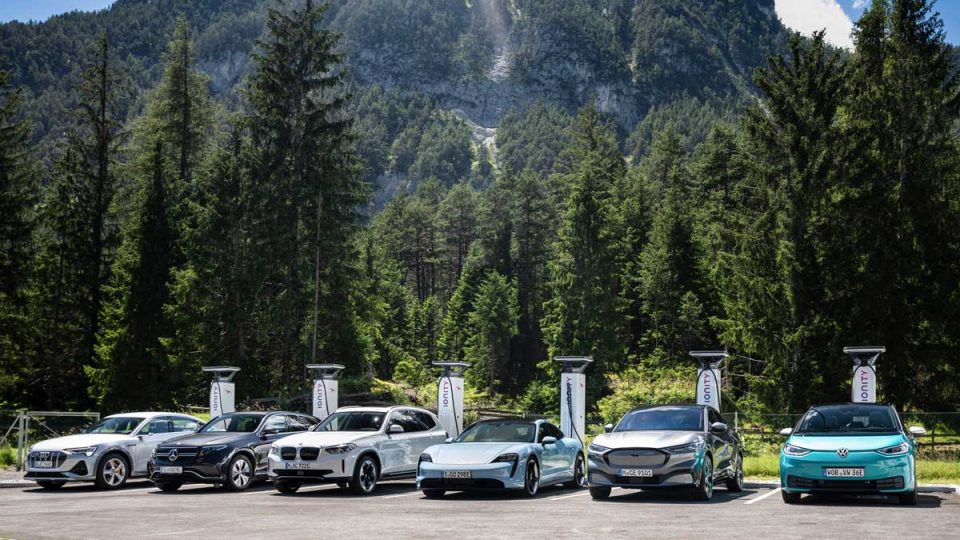While the rest of the world is wring its hands and lamenting that the EV revolution is stalling, electric car sales in Norway are increasing, and Christina Bu, the head of Elbil — the Norwegian Electric Vehicle Association — thinks every new car sold in Norway could be electric as soon as next year. Over 94% of all new passenger cars registered in Norway in August were electric, according to the Norwegian Road Traffic Information Council. The proportion of electric cars for passenger cars is at a record high 94.3% for August and 86.8% so far this year.”This looks very promising for achieving 100 per cent in January,” Bu said.
In the private market, the share of electric cars was 96.7% in August, while the commercial market, with 90.7%, set a new record for the second month in a row. Electric car sales in August are 13% higher than the same month last year, while 65% fewer fossil fuel cars were sold. In total, the number of cars sold in August is on par with last year. For the year so far, car sales are down 7%, with 3% fewer electric cars sold and 28% lower sales of fossil fuel cars. In the commercial sector, 22% of vans — the trucks used by tradespeople and delivery companies — were battery-powered in August as well.
On 1 July, the Norwegian government introduced new tax rules for leasing companies, with the aim of improving the competitiveness of electric cars in this market. The goal is that all new leased cars should be electric by next year. Previously, the leasing and business market bought in a lot of fossil fuel cars, but now this is about to change. “This shows that politics works. If the right steps are taken going forward, it is possible to have an emission-free new car market as early as next year — the first country in the world to do so”, said Christina Bu
In August, all of the top ten best selling cars in Norway were electric, with the Tesla Model Y being the top selling electric car in the country. Here is the Top 10 list:
- Tesla Model Y — 2107
- Volvo EX30 — 932
- Volkswagen ID.4 — 584
- Skoda Enyaq — 582
- Toyota bZ4X — 526
- Audi Q4 e-tron — 369
- Tesla Model 3 — 367
- Volkswagen ID.3 — 344
- BW i4 M50 — 333
- Nissan Ariya — 307
Paying For Electric Car Charging In Norway
One of the issues electric car drivers deal with is how to pay for their charging sessions. In July of 2023, the government began requiring new chargers to include credit card readers, so that charging would be more like paying for gas at the pump. Being able to use a credit card eliminates the hassle of having a half dozen apps or the need to set up individual accounts with a number of charging companies. In a poll, more than 87% of Norwegian drivers said they prefer to pay by credit card, but despite the new law, credit card readers are conspicuously absent at many chargers — especially at Tesla Supercharging locations.
Today, only about 25% of chargers in Norway are able to accept credit card payments. In part, that may be due to a provision in the law that allows charging companies to install chargers that lack readers if they were ordered prior to when the new law took effect. EV charging companies Uno X and Ragde have the option of card payment on all of their fast chargers. Those companies also have several other payment options, including the Elbil charging chip.
Circle K has credit card readers on more than half of its chargers. Ionity has not provided data on card readers at its charging locations. Eviny and Tesla have no chargers that accept credit card payments at all. Odd Olaf Askeland, the head of Eviny, said he thinks it is a shame that his company did not get the first card reader chargers up and running before the summer holidays. “But we have to be 110 percent sure that the payment works, that the customers get a refund if something happens, and we have to take account of all incidents that don’t go by the book.”
What is happening at Tesla, on the other hand, is not easy to know, Elbil says. Tesla has installed its new V4 chargers in several locations in Norway over the past year. And although space has been made for card chargers in a dedicated place on these chargers, there are so far no card terminals to be seen. When Elbil asked Tesla why the card terminals were not in place on new chargers, Tesla replied that “they have no information to share on this matter.”
Elbol has been the driving force behind the demand for card payment on fast charging. Its member services staff gets more inquiries abut credit card readers than any other topic. “It is surprising how big a difference there is in how the charging companies follow up on the requirement. I want to brag about the companies that took the challenge head on and got going. Now the latecomers must follow suit,” says Christina Bu. She said that Elbil is following developments closely. “Our patience is over. I expect that electric car drivers will already be able to find the first fast chargers at Tesla and Eviny that offer card payment in the autumn holidays.”
The Takeaway
Norway is clearly leading all other nations in the adoption of electric vehicles, thanks in large measure to government policies that supported the decision to buy an electric car with financial incentives and non-monetary benefits such as free charging and free parking in Oslo and other metropolitan areas, along with free or reduced tools on ferries and bridges and access to to high occupancy vehicle lanes. In a country where diesel-powered cars were once preferred, the electric car is now the first choice of most drivers.
Norway, of course, is not representative of every country in the world. It does not have vast, wide open spaces like Montana or Wyoming, and most of its residents are not all that interested in driving ginormous pickup trucks to the pharmacy to buy a bottle of aspirin, so attitudes in Norway may vary somewhat from those in countries like the US and Australia where long distance driving is more common. But Norway proves the EV revolution is real and that virtually the entire population of a country can embrace the electric car without risking a total collapse of civilized society. Perhaps the example set by Norway will encourage other nations to see the transition to battery-powered vehicles through to its conclusion.
As reported in Cleantechnica.com

